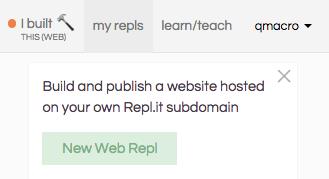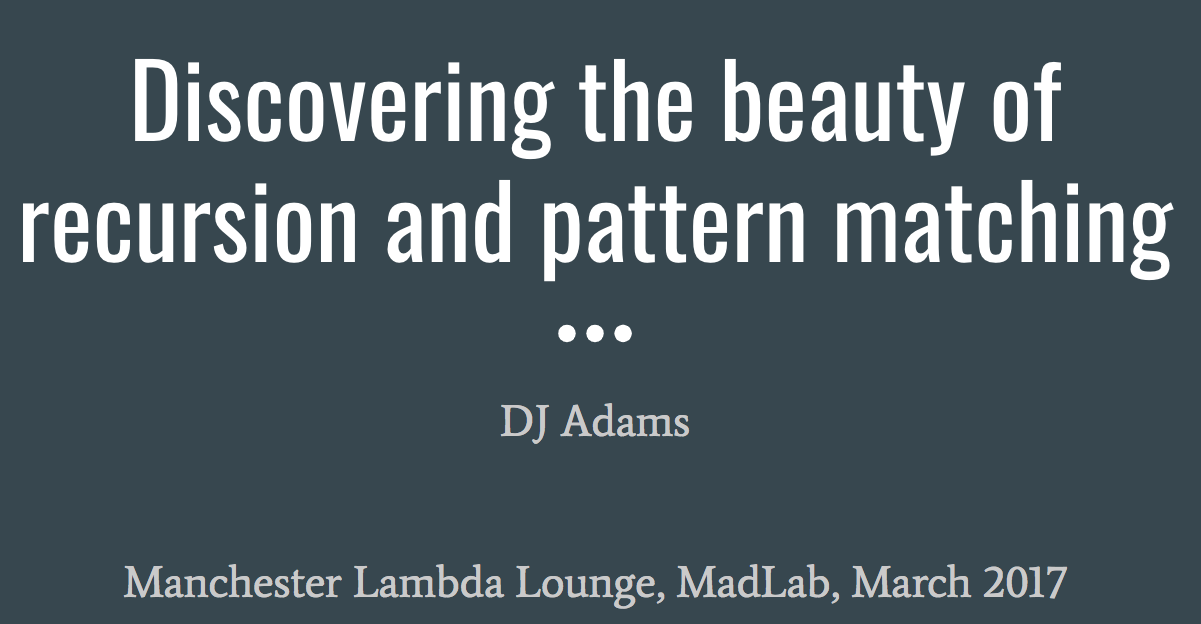Monday morning thoughts: cloud native
This weekend I discovered that one of my favourite online REPLs* - repl.it - has a new feature where you can build and publish a website on a repl.it subdomain:

*REPL: Read Evaluate Print Loop - an interactive language shell
I've used repl.it to explore language such as Clojure and Haskell, for various purposes, including the basis for a talk I gave at Manchester's Lambda Lounge last year: "Discovering the beauty of recursion and pattern matching":

A brief history
The new repl.it feature allows us to create a set of site artifacts, structured into directories, and have them hosted and served by repl.it's infrastructure. I immediately thought of the options to host UI5 based demo apps. One page apps that are built with MVC, internationalisation and other features are necessarily complex in structure, in that there's a lot of moving parts.
Quite a few years ago now I realised I could include XML view definitions and JavaScript controller scripts inside a single HTML file, using custom <script> tags. That extended to the use of JSBin, which has supported OpenUI5 for a while now (see "Small steps: OpenUI5 toolkit now in jsbin.com"), like in this layout example: http://jsbin.com/gatan/edit?html,js,output.
But the ability to create and serve UI5 apps, resplendent in their multi-artifact construction, still remained a desire, which was fulfilled with the advent of Plunkr, similar to JSBin. See this post from Denise Nepraunig for more details on UI5 with Plunkr: "Quickly tinker around with SAPUI5 examples".
The online experience
But I digress. The new repl.it experience isn't a revolution, more an evolution. It is, nevertheless, a very nice experience:

(Yes, this is a little UI5 app that was inspired by Meredith Hassett's recent #APIFriday post "Building your Developer Profile -- GitHub UI5").
I'm mindful of the tools I use with kids at the local Primary School and at Manchester CoderDojo. All the teaching I do, from Google Apps Script, to JavaScript, Scratch and even UI5, is done online. All the kids need is a laptop with enough battery, a connection to the wifi, and a browser.
This is a theme I've followed myself for a good few years, moving a long time ago "to the cloud" with Google productivity tools and latterly with ad hoc tools such as repl.it and of course the excellent SAP Web IDE. Some of you who interact with me on Twitter will know that I recently spent a whole two months using Chrome OS almost exclusively.
So the repl.it offering fits right into the online experience funnel I'm used to. In all that time with Chrome OS I never needed to reach to another laptop to do anything other than connect my running watch with the TomTom app that updated it with new "quick GPS" data (since then I've discovered that the new version of the app on my phone can do that now too). Of course, that doesn't mean I've eschewed the command line - far from it. I've a Google Cloud Shell (free) which gives me a persistent and comfortable working shell environment, with all the amenities one would expect - tmux, vim, the Google Cloud SDK, the Google Cloud Functions emulator, ngrok and even the SAP Cloud Platform Neo environment SDK / console client (the latter two I installed separately, and I have my own configurations for tmux and vim of course).

Cloud native
So anyway, all this got me thinking, on my run this morning. We're moving to cloud native architectures with the Cloud Platform offerings. Interaction is undeniably moving further and further online. That interaction extends to the architecture and development topics, the latter exemplified with the experience I've had thus far.
So I'm wondering: how do we define cloud native? What is the experience, and is it obvious when we see it? It's clear to me, when I spend pretty much my entire day (modulo Outlook) online, in browser windows, where I find myself developing and deploying code, creating content, and configuring interconnectivity and routing with my Cloud Platform Technican's hat on.
Heck, I conceived, built and deployed the artifacts for, and wrote the content for the 10-part series on the SAP Cloud Platform Workflow service ("Discovering SCP Workflow") all online.
With the advent and growth of SAP S/4HANA Cloud, and the PaaS and SaaS tools and facilities that are growing around it to support implementations, customisations and extensions, the cloud native experience is only going to grow. Yes, there are also processes and activities that require local installations of software, most notably for me is the ABAP Developer Tools in Eclipse and of course the venerable SAPGUI itself. But these appear as exceptions in my eyes, rather than the future normal.
What does cloud native mean to you? What defines it for development, for architecture, for our present and future enterprise solutions? I'd love to hear your thoughts via the comments section below.
Read more posts in this series here: Monday morning thoughts.